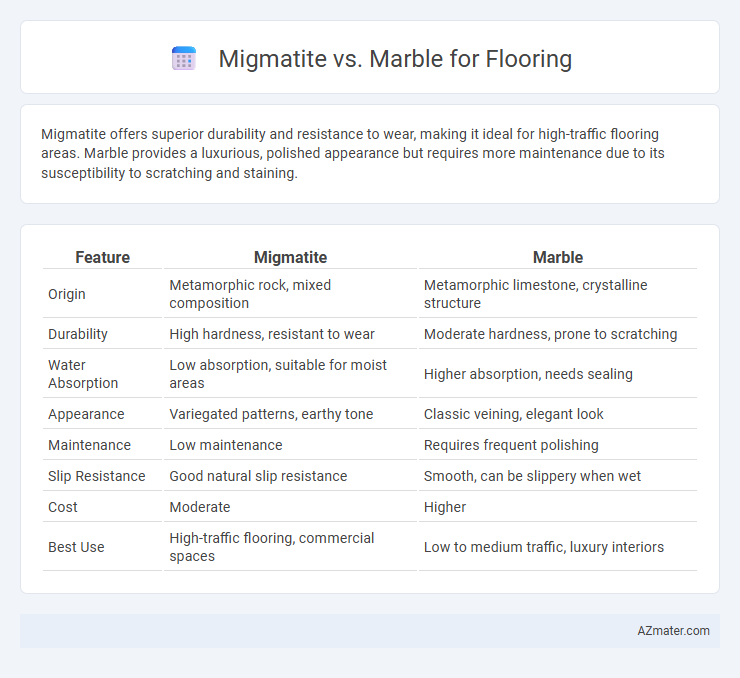Migmatite offers superior durability and resistance to wear, making it ideal for high-traffic flooring areas. Marble provides a luxurious, polished appearance but requires more maintenance due to its susceptibility to scratching and staining.
Table of Comparison
| Feature | Migmatite | Marble |
|---|---|---|
| Origin | Metamorphic rock, mixed composition | Metamorphic limestone, crystalline structure |
| Durability | High hardness, resistant to wear | Moderate hardness, prone to scratching |
| Water Absorption | Low absorption, suitable for moist areas | Higher absorption, needs sealing |
| Appearance | Variegated patterns, earthy tone | Classic veining, elegant look |
| Maintenance | Low maintenance | Requires frequent polishing |
| Slip Resistance | Good natural slip resistance | Smooth, can be slippery when wet |
| Cost | Moderate | Higher |
| Best Use | High-traffic flooring, commercial spaces | Low to medium traffic, luxury interiors |
Introduction to Migmatite and Marble Flooring
Migmatite flooring is prized for its unique blend of metamorphic textures, combining igneous and sedimentary characteristics that offer a natural, variegated appearance with exceptional durability. Marble flooring, composed primarily of recrystallized carbonate minerals, is renowned for its elegant, smooth surface and classic veining, making it a timeless choice in luxurious interior design. Both materials provide distinct aesthetic and functional benefits, with migmatite offering enhanced hardness and marble delivering superior polish and brightness.
Composition and Formation of Migmatite
Migmatite is a complex metamorphic rock formed through partial melting of pre-existing rocks, exhibiting both igneous and metamorphic characteristics with a composition primarily of quartz, feldspar, and mica. Marble, however, is a metamorphosed form of limestone, composed mainly of calcite or dolomite, resulting from recrystallization under heat and pressure. Migmatite's banded structure and mixed mineral phases contrast with the relatively uniform crystalline texture of marble, influencing their appearance and durability as flooring materials.
Marble: Origins and Characteristics
Marble, a metamorphic rock originating from limestone subjected to high pressure and temperature, is prized for its elegant veining and smooth texture. Its crystalline structure contributes to durability and a polished finish, making it ideal for flooring applications in luxury interiors. The natural variation in color and pattern enhances aesthetic appeal, while its relatively soft composition requires proper sealing to prevent staining and wear.
Visual Appeal: Colors and Patterns Compared
Migmatite flooring showcases a unique blend of crystalline quartz and feldspar with intricate, swirling patterns that create a dynamic, natural mosaic effect, often exhibiting earthy tones ranging from soft grays to warm browns. Marble offers striking elegance with its characteristic veining patterns, usually in colors like white, black, green, or pink, providing a polished, luxurious aesthetic. The choice between migmatite and marble depends on the desired visual impact: migmatite emphasizes complex, textured visuals, while marble highlights smooth, classic veining for timeless sophistication.
Durability and Wear Resistance
Migmatite offers exceptional durability and high wear resistance due to its mixed metamorphic composition, making it ideal for high-traffic flooring areas. Marble, while visually appealing with its smooth texture and unique veining, is softer and more prone to scratching and etching, reducing its suitability for heavy-use floors. Choosing migmatite ensures longer-lasting performance with minimal maintenance in commercial or residential flooring applications.
Maintenance Requirements
Migmatite flooring demands minimal maintenance due to its natural resistance to scratches and stains, making it ideal for high-traffic areas. Marble requires regular sealing and polishing to preserve its luster and prevent etching from acidic substances, which increases long-term upkeep costs. Both materials benefit from prompt cleaning of spills, but migmatite offers greater durability with less frequent maintenance interventions.
Cost Analysis: Migmatite vs Marble
Migmatite flooring typically costs between $8 and $15 per square foot, offering a durable and visually unique option due to its natural blend of metamorphic rock textures. Marble flooring ranges from $10 to $30 per square foot, with higher expenses attributed to its luxurious appearance and higher maintenance requirements. Considering installation and upkeep, migmatite often provides a cost-effective alternative for budget-conscious projects seeking aesthetic appeal and durability.
Slip Resistance and Safety Factors
Migmatite offers superior slip resistance compared to marble, making it a safer choice for flooring in wet or high-traffic areas due to its natural, coarse texture. Marble's polished surface, while visually elegant, tends to be more slippery when wet, posing a higher risk of slips and falls. Selecting migmatite enhances safety without compromising durability, especially in environments where slip resistance is crucial.
Environmental Impact and Sustainability
Migmatite flooring offers superior sustainability due to its natural formation process, requiring minimal chemical treatments compared to marble, which often involves energy-intensive quarrying and processing. The extraction of marble generates significant carbon emissions and quarry waste, while migmatite's resilient composition allows for longer-lasting flooring with less frequent replacement, reducing overall environmental impact. Choosing migmatite supports eco-friendly construction by conserving natural resources and lowering the carbon footprint associated with floor installation and maintenance.
Which is Better for Flooring? Final Considerations
Migmatite offers superior durability and resistance to scratching compared to marble, making it a better choice for high-traffic flooring areas. Marble provides unmatched elegance and timeless aesthetic appeal, but it requires more maintenance due to its susceptibility to staining and etching. Final considerations should include the expected foot traffic, maintenance commitment, and overall design preferences when choosing between migmatite and marble flooring.

Infographic: Migmatite vs Marble for Flooring
 azmater.com
azmater.com